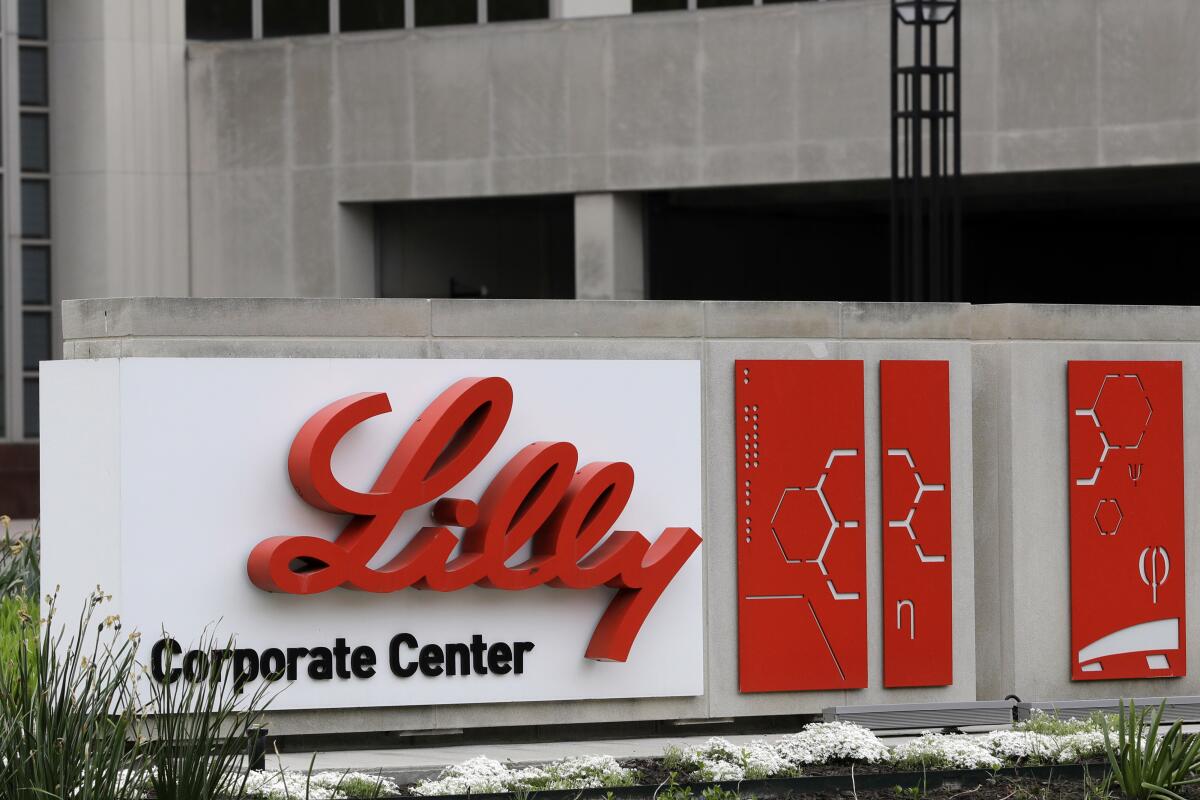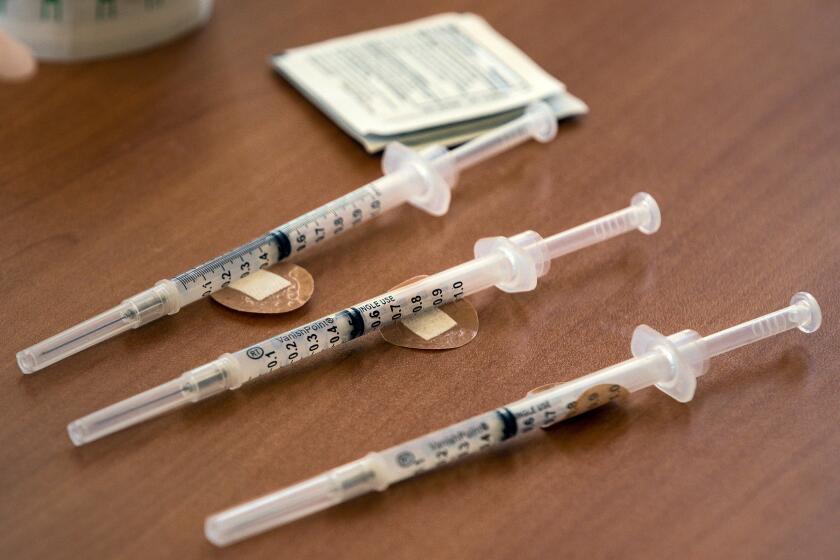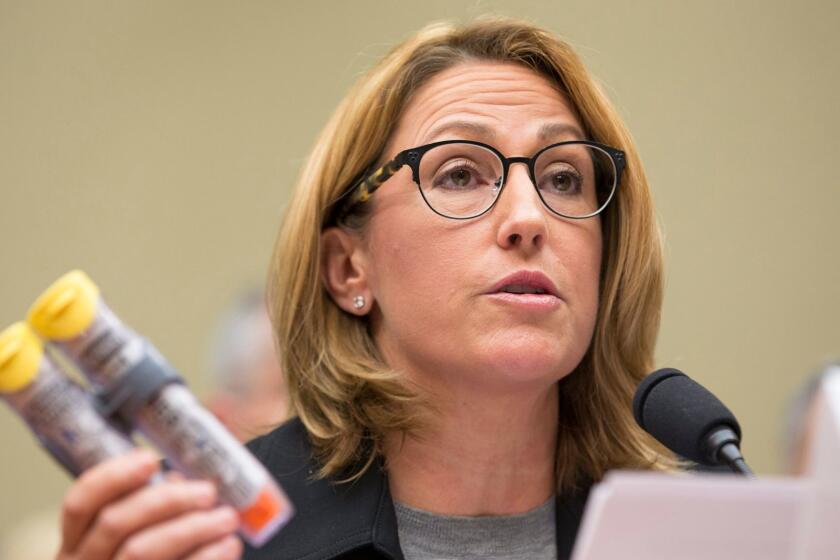Column: Eli Lilly is slashing insulin prices, but hold your applause

Eli Lilly & Co. played the altruism card like a champ on March 1, when it announced steep price cuts on its insulin products of as much as 70%.
The big drug company said its action was all about helping diabetes patients, its goal being to “help Americans who may have difficulty navigating a complex healthcare system that may keep them from getting affordable insulin.”
According to Lilly Chairman and Chief Executive David Ricks, America’s healthcare system “still does not provide affordable insulin for everyone, and that needs to change.”
Lilly is going to bank a lot of goodwill for this, without taking necessarily a big hit to their bottom line.
— Andrew Mulcahy, Rand Corporation
Lilly basked in public praise after the announcement. President Biden observed that Lilly’s cuts would force its two principal competitors, Novo Nordisk and Sanofi, to follow suit.
If you’re inclined to think better of Lilly for taking this dramatic step, here’s our advice: Hold your applause.
The truth is that Lilly’s price cuts won’t cost it a thin dime in profits; it may even collect higher profits. Wall Street recognized that instantaneously: The price of Lilly shares rose on the day of the announcement and has continued to move higher ever since, gaining nearly 6% through Thursday’s trading.
Moreover, the price rollback still doesn’t bring Lilly insulin back to where it should be on an inflation-adjusted basis compared with the price of its key product, Humalog, upon its launch in 1996.
Back then, Humalog cost $21 per vial, which would be about $40 in today’s money; the rollback will reduce the price of a vial from $274.70 to $66.40, according to calculations by the Washington consulting firm Veda Partners. So it’s still higher by two-thirds than it should be, accounting for inflation.
Another factor driving Lilly’s announcement is the intense public scrutiny on insulin’s inflated price. The Inflation Reduction Act passed last August included a provision capping the out-of-pocket cost of insulin for Medicare prescription drug enrollees at $35 a month. That benefit has been widely and loudly touted by President Biden as evidence of his commitment to pro-consumer policymaking.
In line with that legislation, one element of Lilly’s price-cut announcement is a cap of $35 per month on out-of-pocket charges for insured customers. As I’ve reported before, these patient-assistance programs only camouflage for consumers the true costs of their prescriptions — insurers still pay the drugmakers’ high prices, which end up in higher premiums for everyone.
The pharmaceutical industry has been bragging for nearly a decade now about its efforts to help cash-strapped patients pay for expensive prescription drugs.
“Lilly is going to bank a lot of goodwill for this, without taking necessarily a big hit to their bottom line,” says Andrew Mulcahy, senior researcher at Rand Corp. and lead author of a 2020 Rand comparison of insulin prices in the U.S. and other countries.
That analysis showed that U.S. insulin prices were way out of line with the rest of the world: For example, a benchmark unit cost (in U.S. dollars) $6.94 in Australia, $12 in Canada and $7.52 in Britain — but nearly $100 in the U.S. Even if Lilly’s price cuts are followed by its competitors, “U.S. prices are still higher than prices in the other countries,” Mulcahy told me, though by two to three times rather than by 10 times.
Insulin’s high list price has fueled efforts to create alternative sources. California Gov. Gavin Newsom last year announced a $100-million program to manufacture a state-branded low-cost insulin, possibly by contracting with a generics firm; an announcement of details could come within days. A similar effort is underway in Michigan.
Lilly’s price cuts won’t do anything to address the fundamental dysfunction of America’s drug-pricing system, which bristles with rent-seeking entities — not just drug manufacturers but pharmacy benefit managers, or PBMs, middlemen who offer to negotiate lower prices on behalf of health insurers by extracting rebates but keep a share of the purported savings for themselves.
Drugmakers and PBMs point their fingers at one another when high drug prices are challenged in lawsuits or congressional hearings. But there’s no question that the system creates incentives for high manufacturer prices, because those are necessary to provide the headroom for rebates.
Indeed, in 2021 a Senate committee reported that Lilly executives were reluctant to reduce prices on diabetes drugs because they feared PBMs would object: The lowered prices would reduce the fees the PBMs could charge their health plan clients and reduce their ability to meet the rebate guarantees they had promised the clients.
The relationship between drugmakers and PBMs is the issue in a lawsuit filed in Los Angeles County Superior Court by California Atty. Gen. Rob Bonta in January.
Moderna and Pfizer have announced plans to quadruple the price of their COVID vaccines, putting them out of reach for millions. The U.S. should step in.
The lawsuit alleges that the three manufacturers conspired with the three dominant PBMs, CVS Caremark, Express Scripts and OptumRx, to “artificially inflate” insulin prices well beyond the normal inflation rate. None of the defendants has yet responded to the allegations in court.
As it happens, diabetics aren’t even among the drug users most victimized by high prices in the U.S. That’s because having three competing manufacturers for what is essentially a commodity drug leads to large rebates that flow through to insured patients at least to some extent.
Rebates from list prices on insulin have averaged 70% to 80%, Mulcahy and his Rand colleagues reported in 2021. That’s not the case for cancer drugs, which can carry list prices of hundreds of thousands of dollars but tend not to be rebated, or “disease- modifying anti-rheumatic drugs” used to treat autoimmune conditions such as lupus, multiple sclerosis and Crohn’s disease, for which about one-third of list prices are rebated.
“Oncology is the clearest example of drugs where the discounts from list price are slim to none,” Mulcahy says. That’s because the action of these drugs may be specifically targeted, making it difficult to shift a patient from one drug to another in search of a lower price.
Nearly 40 million Americans suffer from diabetes, a disease in which the body either can’t produce insulin, the hormone needed to control blood sugar levels, or can’t efficiently use insulin. Some 7 million of them require daily injections of insulin.
Of those, according to a study by Yale researchers published last year, 14% face “catastrophic” spending on insulin, defined as 40% of their income beyond what they spend on food and housing. Nearly half have reported rationing their insulin supply because of its cost. That’s a life-threatening strategy.
They’re the victims of an enormous run-up in drugmakers’ insulin prices over the last 30 to 40 years. These prices fall into two categories: The list prices, which in the U.S. can currently run to more than $200 per vial, and the out-of-pocket price.
The average patient can use two to four vials a month.
Few patients consistently pay the list price, however. Most are charged only a co-pay by their health plan or even receive insulin at no charge through Medicaid.
The high list price mostly harms patients who have to buy insulin directly, typically because they’re uninsured or have high-deductible health plans that don’t cover all the costs. But even patients with good insurance aren’t entirely protected from the list price, says Shaina Kasper, a diabetes sufferer who is USA policy manager for T1International, a global advocacy group for diabetics.
Diabetes doctor Irl B.
“Sometimes even people with insurance have to buy it out of pocket,” she says. “You break a vial when you’re away on vacation. You run out because something happens. A couple of weeks ago, my dog sitter put a shipment that came into the freezer, and it all died. Having an option of being able to get a more affordable insulin is going to save lives.”
Insulin has become the “poster child for runaway incentives for higher list prices,” as Mulcahy puts it, for several reasons.
These include the sheer scale of the run-up in prices, the vast markup over what it costs to produce — as little as $6 a vial — and the loopholes that insulin makers have exploited to preserve their marketing rights for a product for which the patents would normally have expired decades ago.
One common technique is for manufacturers to bring out new formulations or devices they claim represent significant clinical improvements. Those improvements are often more modest than the manufacturers say, or may not be suitable for all users.
Nevertheless, observes Robin Feldman, an expert on pharmaceutical law at the University of California College of the Law, the changes allow drugmakers to extend their marketing rights.
Sanofi, for example, has filed 74 patent applications for its Lantus long-acting insulin drug, Feldman reports in an upcoming journal article; most were filed after the drug came on the market in 2000 but have allowed Sanofi to extend its marketing rights through 2031.
Coming back to Lilly’s initiative, among the company’s incentives to announce its insulin price cuts now are Medicaid rules kicking in next year that penalize drugmakers for raising prices faster than inflation. The new rules could result in as much as $430 million in charges to Lilly, by Veda’s estimates.
Thanks to the peculiarities of Medicaid pricing, Lilly’s reductions could result in its collecting more than $85 million in new Medicaid revenues, Veda reckons, concluding: Put those two factors together, and Lilly’s price cuts will produce about $517 million in gains.
“Companies act in their own interests,” Feldman says. “This price reduction is no exception. The company is managing to do well by doing good.”
More to Read
Get the latest from Michael Hiltzik
Commentary on economics and more from a Pulitzer Prize winner.
You may occasionally receive promotional content from the Los Angeles Times.














